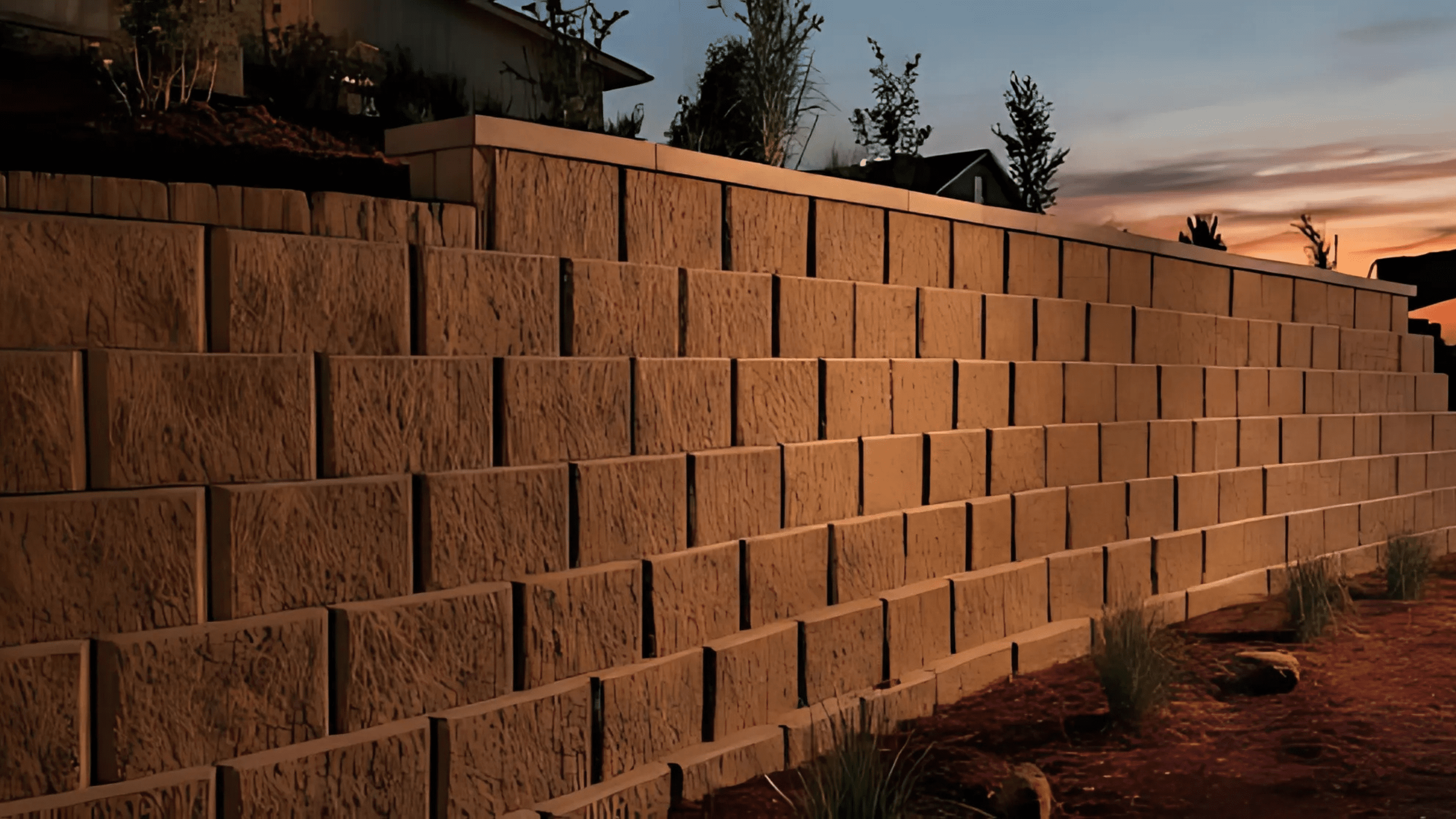
Retaining walls serve to manage and enhance outdoor spaces, especially for properties on sloping ground. Whether you’re looking to prevent soil erosion, maximize usable space, or add a touch of sophistication to your landscape, retaining walls are the perfect solution. At Summit Marine Development, we specialize in designing and building high-quality retaining walls that not only meet your functional needs but also elevate the aesthetic appeal of your yard.
In this blog, we’ll explore the types, costs, and construction of retaining walls, along with tips to avoid common mistakes and insights into choosing the right solution for your landscape.

What Are Retaining Walls Made Of?
Retaining walls can be built from a variety of materials, including:
- Stone: Natural and aesthetically pleasing, perfect for blending into your landscape.
- Concrete: Durable, customizable, and ideal for modern designs.
- Timber: Cost-effective and great for rustic landscapes but has a shorter lifespan.
- Gabion Walls: Made from metal cages filled with rocks, an eco-friendly and budget-friendly option.
Each material has its advantages, and Summit Marine Development can help you choose the one that suits your budget, soil type, and design preferences. Proper material selection ensures a stable wall structure that enhances your property for years to come.
Benefits of Retaining Walls
Retaining walls offer numerous benefits for your yard, including:
- Preventing Soil Erosion: Stabilizes sloping ground to prevent loss of soil during rain.
- Maximizing Usable Space: Creates flat areas for gardens, patios, and play zones.
- Enhancing Landscape Design: Adds texture, structure, and visual interest to your outdoor space.
- Improving Drainage: Properly designed walls control water runoff and prevent flooding.
- Boosting Property Value: A well-built retaining wall increases curb appeal and functionality.
Whether you need to stabilize your sloped ground or create a beautiful new landscape design, retaining walls from Summit Marine Development offer long-term benefits for your property.

Why Your Property Needs a Retaining Wall in Landscape Design
Retaining walls are essential for properties with sloping ground or uneven terrain. They:
- Prevent Soil Erosion: Protect your landscape from washouts caused by rain or water runoff.
- Create Flat, Usable Space: Turn slopes into functional zones for planting or outdoor activities.
- Enhance Aesthetic Appeal: Retaining walls add depth and beauty to any yard.
- Direct Water Runoff: Prevent pooling and flooding in your outdoor spaces.
Summit Marine Development specializes in retaining walls that balance functionality and aesthetic appeal, creating landscapes that are both practical and beautiful.

What Are the 4 Types of Retaining Wall Systems?
Understanding the various types of retaining walls is essential for selecting the best option to suit your yard’s specific needs:
1. Gravity Retaining Walls
- Rely on their weight to hold back soil.
- Often constructed from stone, concrete, or bricks.
2. Cantilevered Retaining Walls
- Feature a reinforced base for added stability.
- Ideal for larger slopes or heavier loads.
3. Anchored Retaining Walls
- Use cables or anchors for additional supprt.
- Perfect for steep slopes or unstable ground.
4. Sheet Piling Retaining Walls
- Thin walls driven deep into the soil, often made of steel or wood.
- Suitable for tight spaces or soft ground conditions.
Not sure which type of retaining wall is right for your landscape? Summit Marine Development can help you select the ideal system for your specific property.

Are Retaining Walls Expensive to Build?
The cost of retaining walls depends on materials, labor, and the size of your project. While some options, like cantilevered walls, may be more expensive, there are budget-friendly alternatives:
- Timber Walls: Great for smaller projects but less durable.
- Gabion Walls: Cost-effective and eco-friendly.
- Dry-Stacked Stone Walls: Easy to install and ideal for DIY projects.
At Summit Marine Development, we create retaining walls tailored to your budget without compromising quality.
7 Common Mistakes to Avoid When You Install Retaining Wall Blocks
Avoid these common mistakes to ensure a strong and durable retaining wall:
- Skipping Proper Planning: Failing to account for soil type, slope, and water drainage.
- Ignoring Drainage Systems: Poor drainage can lead to wall failure.
- Using Incorrect Materials: Some materials are unsuitable for certain soil conditions.
- Overloading the Wall: Not accounting for the weight of soil or nearby structures.
- Improper Leveling: An uneven foundation weakens the structure.
- Ignoring Local Building Codes: Non-compliance can lead to costly fines or repairs.
- Improper Backfill: Using the wrong backfill material can reduce wall stability.
Hire Summit Marine Development to ensure these pitfalls are avoided and your wall is built to last.

How to Build a Retaining Wall
Tools and Materials Needed
- Tools: Shovel, level, compactor, measuring tape.
- Materials: Retaining wall blocks, gravel, drainage pipes, and backfill.
Step-by-Step Guide
- Plan and Measure: Determine the wall’s location and size.
- Excavate and Lay the Foundation: Dig a trench and create a solid base of gravel.
- Build the Wall: Lay the first layer of blocks, ensuring they are level.
- Install Drainage: Add drainage pipes to prevent water buildup.
- Backfill: Fill the space behind the wall with gravel or soil for support.
- Finish the Wall: Add capping stones and decorative elements.
While smaller projects can be DIY, complex retaining walls are best handled by professionals like Summit Marine Development.

Why Choose Summit Marine Development for Your Retaining Wall Project?
At Summit Marine Development, we specialize in crafting retaining walls that seamlessly combine functionality, durability, and aesthetic appeal. With years of experience, we deliver tailored solutions designed to meet the unique needs of your property, whether it involves stabilizing sloping ground, preventing soil erosion, or enhancing your landscape’s design. Our commitment to craftsmanship and attention to detail guarantees that your retaining wall not only serves its purpose but also enhances the beauty of your yard.
Choosing Summit Marine Development means partnering with a trusted team that values expertise, clear communication, and customer satisfaction. We handle projects of all sizes, comply with local building codes, and offer competitive pricing without compromising quality. From consultation to completion, we’re here to create a retaining wall that exceeds your expectations and transforms your outdoor space.

Conclusion
Retaining walls are essential for stabilizing sloping ground, enhancing your yard, and preventing erosion. Whether you’re looking to create a more functional outdoor space or add a stunning feature to your landscape, Summit Marine Development has you covered.
Contact us today or visit our website for expert retaining wall construction tailored to your property. Let us help you create a landscape that’s beautiful, durable, and practical!
Frequently Asked Questions
1. Do landscapers build retaining walls?
Yes, many landscapers specialize in designing and building retaining walls. At Summit Marine Development, we offer professional retaining wall construction tailored to your property’s needs, combining functionality and visual appeal.
2. What is the cheapest retaining wall option?
The most cost-effective retaining wall options include:
- Timber walls: Affordable and easy to install but may not last as long as other materials.
- Gabion walls: Budget-friendly and eco-friendly, consisting of wire cages filled with rocks.
- Dry-stacked stone walls: Perfect for DIY projects and small budgets.
3. Can I build a retaining wall myself?
Yes, smaller retaining walls (under 4 feet tall) can be built as DIY projects if you have the necessary tools and knowledge. However, for larger, more complex walls, professional help is recommended to ensure proper drainage, stability, and compliance with local building codes. Summit Marine Development can handle projects of any size to guarantee a long-lasting and safe result.
4. What is the lifespan of a retaining wall?
The lifespan depends on the materials used:
- Concrete walls: 50-100 years with proper maintenance.
- Stone walls: 50+ years (natural stone lasts longer).
- Timber walls: 10-20 years, as they are prone to weathering.
Professional construction and maintenance by Summit Marine Development can significantly extend your retaining wall’s durability.
5. Does a retaining wall require a drainage system?
Yes, proper drainage is essential to prevent water buildup behind the wall, which can lead to cracks, bulging, or complete failure. Most retaining walls include perforated drainage pipes and gravel backfill to redirect water away from the structure.
6. How tall can a retaining wall be?
- DIY retaining walls: Usually limited to 4 feet tall.
- Professionally installed walls: Can exceed 4 feet and may require reinforcement or engineering approval. Local building codes may regulate maximum height, and taller walls often require a permit. Summit Marine Development ensures compliance with all regulations.
7. Can a retaining wall be used as a fence?
While retaining walls are primarily designed to hold back soil, they can double as a foundation for fences. For example, adding a fence on top of a retaining wall can provide both privacy and stability. Our team at Summit Marine Development can incorporate fencing into your retaining wall design.
8. Are retaining walls environmentally friendly?
Yes, some retaining walls, such as gabion walls and natural stone walls, are eco-friendly options. They use natural or recycled materials and have minimal environmental impact. Summit Marine Development can recommend sustainable designs for your project.
9. Do retaining walls increase property value?
Absolutely! Retaining walls can enhance your property’s curb appeal, improve usability, and protect against erosion, all of which contribute to increased property value. With a professionally installed wall from Summit Marine Development, you’ll enjoy both functional and financial benefits.
10. Can a retaining wall collapse?
Yes, a poorly designed or improperly constructed retaining wall can fail. Common causes of collapse include:
- Lack of drainage.
- Improper backfill or soil compaction.
- Excessive weight or pressure behind the wall.
Hiring professionals like Summit Marine Development reduces the risk of failure and ensures a durable structure.
11. Do retaining walls require maintenance?
Regular maintenance helps prolong the life of your retaining wall. This includes:
- Checking for cracks or bulging.
- Cleaning drainage pipes.
- Removing vegetation that may damage the structure.
Summit Marine Development offers maintenance services to keep your retaining wall in excellent condition.
13. Can retaining walls be decorative?
Yes! Retaining walls can be both functional and decorative. Materials like natural stone, bricks, or concrete blocks come in various colors and textures to enhance your landscape design.
Summit Marine Development specializes in creating retaining walls that are as beautiful as they are practical.
14. What is the difference between a retaining wall and a seawall?
While retaining walls are used to hold back soil on sloped land, seawalls are specifically designed to protect shorelines from water erosion.
If your property requires shoreline protection, Summit Marine Development also specializes in seawall construction.
15. How do I know if I need a retaining wall?
You might need a retaining wall if:
- Your property has significant slopes or uneven terrain.
- You’re experiencing soil erosion or water runoff issues.
- You want to create leveled areas for landscaping or outdoor living.
Contact Summit Marine Development for a consultation to determine the best solution for your property.


